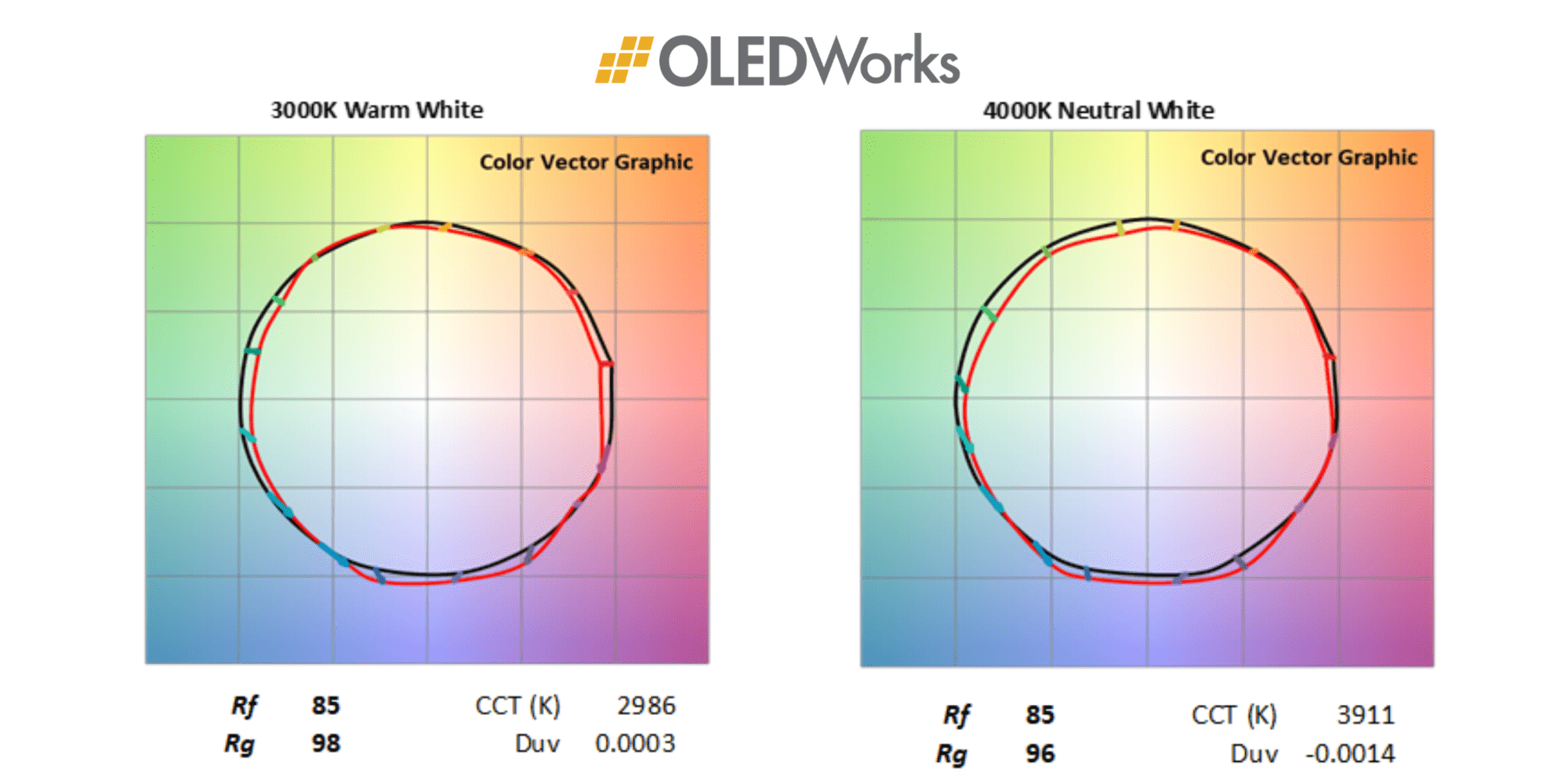
By Jeff Spindler, Director of Product Commercialization
Anyone who has taken a walk through the paint section of a hardware store knows the importance that lighting plays on color. Nothing is more frustrating than finding the perfect color, only to take it home and see that it looks completely different under your home lighting, and different again under the sun. But lighting and color can play significant roles in our lives beyond aesthetics, even impacting our health and well-being.
The Impact of Color Rendering
Color rendering is the ability of a light to accurately render the real-life color of an object. In a recent OLEDWorks blog, Dr. Kathleen Vaeth analyzes the different methods that inorganic LED and Organic LED (OLED) lights use to achieve broad spectrum white light. With each different illumination method comes a different emission spectrum, and this spectrum is what drives a light’s color rendering ability. The ability of a light to render color accurately is an important and valuable characteristic that should not be overlooked. The first benefit is aesthetic. Quality color rendering makes colors appear more similarly to how they would in daylight, improving the aesthetic performance of a space. If a designer wants to incorporate a bright red color, and the light in the space has a poor R9 rating, the red may appear dull, muted, or even a completely different shade.

CRI comparison, courtesy of Inlineelectric.com
Beyond aesthetic, the ability to render colors accurately plays an important role in the ability to perform. In healthcare settings, color and/or discoloration are used to assess potential injury or illness. And in machine vision systems color rendering is crucial for quality control in manufacturing and diagnostic processes. In broader applications, studies have shown the impact that certain colors play on our emotions and cognitive function. The colors red and blue have been shown to enhance cognitive skills, with red able to boost detail-oriented tasks and memory retention by as much as 31%.
This ability to render color accurately is most widely measured in a CRI value (Color Rendering Index). As the number increases, the light is assessed as more accurately rendering the color of an object, with a perfect score of 100 being the equivalent of standardized daylight or a black body. While the CRI is the most widely used measurement for color rendering, it only measures how a light renders eight pastel colors, with an additional ninth value (R9) for bright red rendering. This leaves open the possibility for engineers to manufacture their light to render these nine values, and all others poorly. An emerging metric that is gaining popularity is the TM-30 metric. This measurement uses 99 color evaluation samples to analyze color fidelity, making it a more comprehensive analysis of color rendering. OLED lighting’s natural broad-spectrum emission grants it high color rendering abilities. With a CRI over 90, R9 over 50, and TM-30 measurements of 85 (Rf) and 98 (Rg), these combined metrics demonstrate the ability of OLEDWorks’ Brite 3 OLED lighting panels to render a wide array of colors accurately, without the need for any additional components or electrical elements to aid in this process. The TM-30 color vector graphics for Brite 3 warm white (3000K) and neutral white (4000K) OLED panels show that nearly all colors are rendered very well.
Color Temperature and Well-being
With regards to lighting and color, there is a second area of focus beyond the ability to render color: the apparent color of the light source. The Correlated Color Temperature (CCT) defines the appearance of a white light and is measured in degrees Kelvin (K). The lower the temperature of the light, the warmer it is (2700K), and the higher the number, the cooler the light is (5000K).

CCT comparison, courtesy of American Green Lights
Over the last few years, research has increasingly shown the dramatic impact that color temperature can play for our health and well-being. One major affect that lighting plays on the body is its impact on our circadian rhythms. Circadian rhythms are 24-hour cycles that affect bodily functions, the most popular being the sleep/wake cycle. The human body has evolved so that its sleep/wake cycle mirrors that of the sun, making lighting a key indicator of when we should be asleep, and when we should be awake. In the morning and early afternoon, natural lighting is at a cooler color temperature and carries more blue light waves, increasing alertness, productivity, and concentration. As the day goes on, the light becomes warmer, and the blue light content decreases, gradually decreasing this alert state as your body prepares for sleep. This is why doctors and sleep pathologists have warned against blue light exposure from phones and television too close to sleep, as it can increase your alertness, and throw this delicate cycle out of balance. OLED lighting technology contains no UV light and low short-wave blue content, even at neutral color temperatures (4000K), making it a healthy choice for circadian rhythm management in sleep areas and for evening lighting.
Looking Forward – Tunable White OLED Lighting
Tunable white lighting has become more common to align lighting performance with natural circadian rhythm. The benefits of systems such as these are profound. In a study done on the effect of dynamic lighting on a primary school in Hamburg, Germany, student reading speeds increased by 35%, frequency of errors fell nearly 45%, and restlessness was reduced by 75%.
To this end, OLEDWorks has been working on the development of tunable white OLED lighting through a Department of Energy sponsored project. The goal of the project is to achieve rapid color change over one decade of current (50mA to 500mA), with a tunable range of between 2700K and 5000K. This would allow OLEDWorks to work with luminaire manufacturers in developing lighting solutions that focus on circadian rhythm management. Healthcare settings, for example, would benefit by using cooler color temperatures to keep nurses and doctors alert during the daytime, while allowing for lighting to adjust to warmer color temperatures at night and during periods of rest.
OLED lighting has several benefits over other tunable technologies. Firstly, tunable white OLEDs will still have every benefit of traditional OLED lighting. Users will have access to a healthy light source that is naturally free of glare, free of damaging UV light, and free of flicker – all within a slim profile that is energy efficient and sustainable. In addition, OLED lighting naturally shifts warm as lights dim, compared to inorganic LEDs that tend to shift cool. This is a substantial benefit, as lighting should dim (preferably to warm) as the day progresses and we come closer to sleep, coinciding with the natural dimming of the light from the sun. If a light shifts cool as it dims however, this will increase the blue light content in the light and make us more alert, counteracting our natural circadian rhythm. Some LED professionals have created products that are modified to shift warm, but this requires additionally complex components and driving, which increases costs. This leads us to the third key benefit of color tunable OLED technology, which is simplicity and cost. While LED technology can achieve color tunable technology, there is an increase in complexity of the fixture, as well as a noticeable cost difference compared to their fixed color models. With the current OLEDWorks strategy, tunable white OLED lighting will not increase fixture complexity, and will be able to be manufactured with a minimal difference in price.
With the importance that color plays in our spaces and on our well-being, it is crucial that our lighting can provide us with the best color experience. If you are interested in seeing the premier performance of OLED lighting, try out one of our Developer’s Kits and discover the benefits of OLED for yourself.





